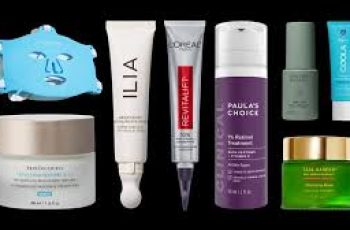
Filler for Acne Scars: Everything to Know About the Minimally Invasive Treatment
An acne scar is like the guest who you never invited to your party, but shows up anyway. After a pimple heals, your skin doesn’t always bounce back to how it looked before, and instead you end up with a mark that’s red, raised, pitted, or even discolored. “It happens when your skin tries to repair itself, but doesn’t quite do it perfectly,” says double-board-certified dermatologist and Mohs micrographic surgeon Saami Khalifian, MD. If you’ve ever wondered if there’s anything you can do, we have good news: Increasingly, people are turning to dermal fillers for acne scars, using the injectable solution to fill depressions and grooves after a pimple heals.
Trying to wave goodbye to stubborn marks? Ahead, learn all you need to know about fillers for acne scars, complete with insights from dermatologists and plastic surgeons.
Meet the Experts
Ruth McTighe, MD, is a board-certified dermatologist at Waccamaw Dermatology in Mt. Pleasant, South Carolina.
Saami Khalifian, MD, is a double board-certified dermatologist and Mohs micrographic surgeon at Som Aesthetics.
Steven Dayan, MD, is a double-board-certified plastic surgeon at Impressions Chicago: Face + Body.
Why Choose Fillers for Acne Scars?
Dermal fillers are a helpful way to correct scars that appear after a breakout. With some dermal fillers such as hyaluronic acid, you might even see results right away. “Using filler is a one of several ways to restore form and function to acne-scarred skin,” Khalifian says. “It is important to note, however, that using filler for acne scars does represent an advanced treatment technique and is considered an off-label use of these products.”
If you’re feeling frustrated or self-conscious about your acne scars, fillers are a treatment option to consider. But you’ll want to keep in mind that fillers only work on certain types of acne scars: “Fillers can be used for acne scars that have left a depression or pit in the skin,” Khalifian says.
What Fillers Are Available to Treat Acne Scars?
Bellafill
Bellafill is a type of dermal filler that’s FDA-approved for the long-term treatment of moderate or severe atrophic acne scars, which are indented scars.1 Bellafill fillers are only available to people over the age of 21. They’re made from bovine collagen, which is sourced from cows, and polymethyl methacrylate (PMMA) beads.2 This type of filler works by supporting and adding volume to the skin.
Hyaluronic Acid
Hyaluronic acid dermal fillers, such as Juvederm and Restylane, are fast-acting acne scar treatments. These work by temporarily increasing volume and stimulating collagen production to improve depressed acne scars, says board-certified dermatologist Ruth McTighe. “The treatment is fairly painless when used with topical numbing agents, and you can walk out of the clinic with results the same day,” Khalifian says.
Poly-L-Lactic Acid (Sculptra)
Poly-L-lactic acid (Sculptra) works gradually (meaning you won’t see results instantly) to improve the appearance of acne scars by stimulating collagen production, McTighe explains.
Radiesse
Radiesse is a calcium hydroxylapatite-based filler that immediately enhances the volume of skin and promotes collagen production over time, McTighe tells us. Research shows that it’s effective for the treatment of depressed acne scars. “When Radiesse is diluted to specific ratios, it can provide a more immediate result than Sculptra, since it gives an immediate lift as well as collagen and elastin stimulation long term,” Khalifian says.
The Cost
Acne fillers vary in price, but they often range from $600 to $1200 per syringe of filler. “The number of syringes and treatment sessions needed depends on the individual and the quantity of scars,” McTighe says. “Most fillers are temporary, lasting from six months to two years, depending on the type of filler, the treatment area, and how quickly the individual’s body breaks it down.”
The Procedure
Before getting any fillers injected into your skin, you’ll have a consultation with a healthcare provider experienced in dermal filler injections, such as a dermatologist. “Because this is not an “on-label” use for fillers, it may be harder to find a provider who is comfortable with the treatment,” Khalifian says. “Furthermore, the techniques employed for acne scars are more nuanced than a standard injection technique, and therefore should be performed by providers with experience in using these products specifically to treat acne scars.” At your consultation, your doctor will assess your acne scars, and you can ask questions about dermal filler costs, what to expect, risks, potential outcomes, and alternative treatment options.
Next, it’s time for the filler. “The treatment area will be cleansed, and typically, a topical numbing cream will be applied,” McTighe explains. “The filler is then injected into the acne scars using a small needle or cannula. Appointments generally last 30 to 60 minutes, depending on the provider.”
Side Effects and Risks
You might experience redness, bruising, or swelling after the procedure, but these side effects tend to be minimal. It’s important to follow any instructions your doctor provides regarding aftercare. “The injection of filler is typically well-tolerated, but as with any procedure, there are potential risks,” McTighe says. “These include injection site reactions such as redness, swelling, bruising, pain, bumps, bluish discoloration of the skin, infection, and hypersensitivity.”
It’s also important to see an experienced healthcare practitioner who can assess your skin and come up with the best approach for you. “While fillers are generally safe with few risks, selecting an experienced practitioner is crucial,” says double-board-certified plastic surgeon Steven Dayan. Be sure to let your provider know if you have any allergies or sensitivities, and contact them for advice if any signs of a bad reaction pop up.
Alternatives
While fillers can be a helpful way to treat acne scars, they aren’t your only option. Below are a few alternatives that your provider may consider, depending on your budget, concerns, and the severity of the scars.
Microneedling
Microdermabrasion
Chemical peels
Laser resurfacing
Fat transplant
Surgical options like subcision
Sometimes, your provider will take a combination approach, using two or more treatment methods to improve results, based on your individual needs. “For those looking for more significant results, a combination of treatments is often recommended,” Dayan says. “Laser resurfacing and dermabrasion, coupled with fat transfer, are highlighted as effective methods for achieving more substantial improvements in skin texture.”
The Final Takeaway
If you’re looking for a minimally invasive acne scar treatment, dermal fillers are a solid option. Dermal fillers aren’t FDA-approved for all types of acne scars, but they’re often prescribed off-label to treat depressed scars. With some types of fillers, like hyaluronic acid, people see results right away, while others take time to work. As with any treatment, it’s important to see a qualified specialist to learn more about this treatment approach and find out if it’s a good option for you.


